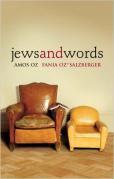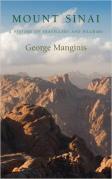While looking for another of his books in a London bookshop, I came across Jews and Words by Amos Oz and his daughter Fania Oz-Salzberger – he a novelist and she a historian. It is intriguing, funny and enlightening, with some pertinent comments and observations that speak into contemporary discussions of Israel, Judaism and Jewishness. I would be interested to hear a response to the book from someone who intuits (because inhabits) the Jewish cultural worldview being explored. The key line is that the authors, both atheists, see the vitality of a “textline” over a “bloodline”.

So, it might seem odd to link that to a very different book: Mount Sinai: A History of Travellers and Pilgrims. Written by George Manginis, it is a detailed account of what most people know as Mount Sinai. In fact, he describes it early on as a “biography” of Moses' Mountain, deriving this from archaeological interpretation, historical analysis, art historical appreciation and textual criticism.
He might have added “fashion history” to the list. The fascinating and vivid account of life in this place includes almost passing reference to the transience of some resident communities. Referring to some time around 300AD he quotes:
And they [the savage nation of Vlemmyes], hoping to find riches, came to plunder the monks; since they found nothing but woven mats and the saints themselves wearing animal hair garments, they were outraged and slaughtered them, even though they did no harm.
When you stand back and survey the great sweep of the entire history of the known universe (for starters), how do you count the significance of some men who (a) chose to live as monks in a desert, (b) had a basic line in clothing, and (c) met a grisly death for no apparent reason other than that they disappointed their killers?

This is a pertinent question in a world in which we have become used to hearing stories of whole communities being summarily wiped out by people who fundamentally dislike them. It focuses Primo Levi's post-Auschwitz question about what is a human being? Is a life valuable when lived in obscurity (as most are) and ended in cheap violence? The Christian answer is clear, but this is a contested matter in a world in which ethics too often are discussed in purely utilitarian terms.
Anyway, that's a digression. The biography of Mount Sinai allows stories to be told by people who have been there. These are people who have travelled, lived, sojourned, invaded, worshipped, hidden and traded in a place trout of by many as holy. They bring their diverse motives and conflicted contributions to a place that, if the stones could speak, would tell much about what human beings are really like. Holiness does not dwell in splendid isolation from the real world, but somehow flickers a fragile flame amid the usual stuff, business and horrors of the world we all know.
I have not been to Sinai, and I know little of the development of the area. Its history is not one with which I am very familiar (where is Tom Holland when you need him?). But, this book, bringing together the several disciplines that tell its story, is rich in detail, agile in narrative, and evocative in mood. It makes me want to go there. As the book concludes:
What makes Jabal Musa interesting for the scholar, fascinating for the visitor, and hallowed for the believer is the layering of worship; the stratigraphy of devotion. The place continues to inspire awe, to be seen as a refuge and to attract pilgrims. The immutability of its rituals is the measure of its importance… Modernity denies or ignores tradition. For some, Jabal Musa is just a mountaintop. For most, it remains a holy place.
 Posted with Blogsy
Posted with Blogsy
